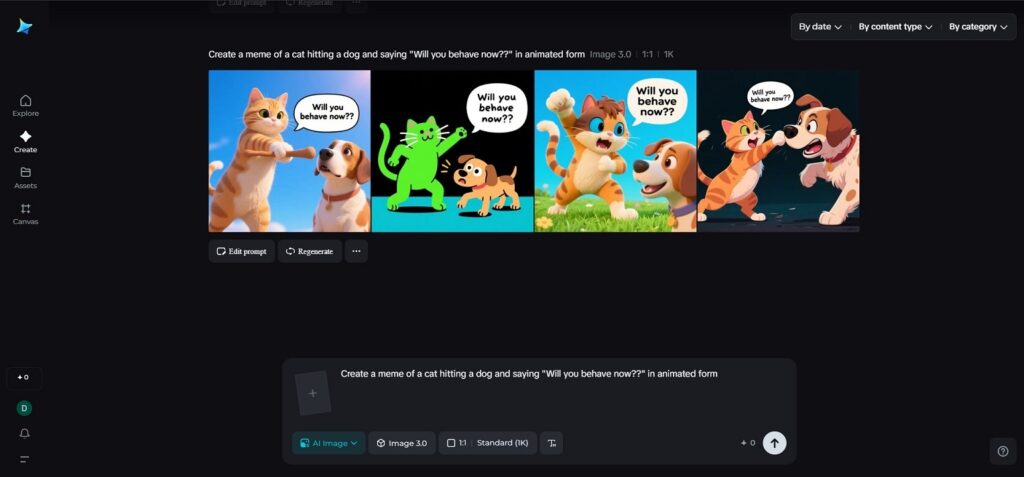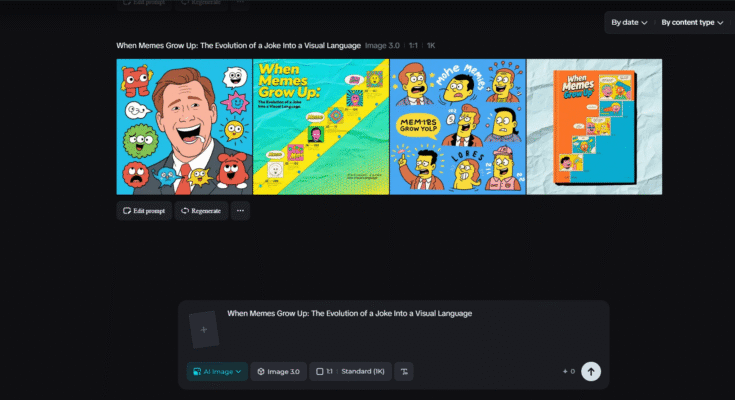Memes begin life as small accidents — a miscaptioned picture, a cropped screengrab, an odd facial expression — and then, somehow, they become infrastructure: a shorthand for emotions, natural, aesthetics, and in-jokes. If you’d like to prototype the way that a meme can evolve into a reliable visual vocabulary, Dreamina can assist: employ an AI photo generator to mock up initial iterations, experiment with tonal adjustments, and envision the way the image will appear following dozens of cultural revisions.
What follows is a lighthearted, useful examination of memes evolving, becoming stabilized, and finally instructing entire groups to convey complex expressions using one image. Start exploring with Dreamina!
The germination: jokes that stick
A meme’s existence starts in stickiness — a property that prompts individuals to imitate, remix, and pass on.
- Surprise + recognition: a symbiosis that turns an intimate experience into something world-readable.
- Editability: the simpler it is to replicate, crop, or caption, the sooner it gets around.
- Emotional efficiency: one frame that says frustration, joy, or schadenfreude is worth its weight in gold.
Early adopters play the role of seed planters: they caption, text-layer, and transpose contexts. The initial remixes try out whether the image is semantically flexible — can it be “tired” one day and “exalted” the next? Those who can endure repeated readings are the prospects for maturation.
Adolescence: rules arise from chaos
As a meme is remixed, groups start to impose tacit grammar. The chaos sorts itself out.
- Caption conventions (top-text vs. bottom-text vs. long-form thread) become dialects.
- Recurring motifs (a prop in the background, a twitch of the face) become morphemes — smallest units of meaning.
- Meta-templates emerge: pre-baked frames people fill with their own content.
This phase is raucous. Look for literal-minded reproductions mixed with high-level, layered parodies. It’s where a meme discovers what it can and cannot say.
Meme dialects and subcultures
Various communities domesticate memes for local purposes. A ceremonial meme in one community can be ironic in another.
- Signal communities: niche groups employ the meme as a badge — a means to signal who the insiders are.
- Satirical communities: they weaponize the form to mock the mainstream iteration.
- Institutional adoption: brands, media, and institutions appropriate the meme — sometimes killing it, inflating it.
Dialects enable the same image to hold several, layered meanings. A clever creator observes where a meme becomes local and learns to use that dialect instead of shouting in the wrong voice.

Visual grammar — how images begin to read like words
When memes solidify, they acquire reproducible visual grammar.
- Positioning is syntax: a thing on the left may suggest cause; on the right, effect.
- Color changes become mood indicators: washed-out colors indicate irony; vivid colors indicate sincerity.
- Repetition and order become narrative punctuation: three panels = setup/punchline/aftershock.
Artists skilled in these new rules can create variants that read immediately, no caption needed. That’s when a meme advances to genuine visual language.
Institutionalization: design meets meme
At some scale, designers and communicators glimpse utility. Memes are shorthand in UX, onboarding, and microcopy because they convey tone quickly. This is where more formal tools come into play — rapid-branding, templating, and even tiny emblem systems.
Dreamina’s AI logo generator can assist teams in developing small mark systems that are reminiscent of meme grammar: repeat corner sigils, micro badges, or reaction stamps that are memetic but branded. The secret is subtlety: a stamped mark needs to be native, not watermark-y.

Memetic literacy: educating individuals to read (and write)
As literacy-educated individuals in the skills of reading words, memetic literacy educates audiences in the skill of reading layered images. Interpretive schools arise:
- Newcomer guidelines: safe reading — literal initial, ironic subsequently.
- Power user maneuvers: strategic remix, context-switching, and meta-commentary.
- Translation methods: how to translate meme grammar between cultures and languages without detracting from the joke.
Promoting memetic literacy in communities or teams requires developing guides, publishing templates, and demonstrating proper remix manners.
When a meme turns into a protocol
Adult memes occasionally turn into protocols for action — little rituals that individuals do because the structure demands it.
- Reaction economy: rather than “liking,” individuals apply a meme to convey specific emotional states.
- Ritual replies: a particular meme used to end threads, offer condolences, or celebrate victories.
- Template-based communication: common templates for reporting, voting, or narrating, in which the meme is formed.
Protocols are strong because they condense decision-making. You don’t require an extended message when a known image cues the next action.

The meaning lifecycle — birth, drift, canonization
Meaning never ceases to move. Even canonized memes continue to drift.
- Birth: swift, messy, celebratory.
- Drift: multilayered remixes, local dialects, and ironic distance.
- Canonization: being included in reference lists, archived templates, and institutionalized applications.
- Resurrection: forgotten memes can come back, freshly reinterpreted by subsequent contexts.
Archivists, both professional and hobbyist, contribute to fixing what is canonical. They harvest templates, store early forms, and track usage patterns.
Design implications: how creators can be caretakers of memes
Meme creators who wish to tend a meme responsibly can garden:
Seed deliberately, but let grow wild.
- Templates: Release editable templates to facilitate remix instead of theft.
- Offer provenance: indicate the original source to minimize erasure.
- Model remix manners: acknowledge, permission where necessary, and respect for contexts.
Approaching memetic creation as stewardship generates goodwill and longevity.
Technologies that facilitate memetic acceleration
Generative tools accelerate ideation and iteration without substituting for taste. Artists and community managers employ them to rapidly test variants.
- Rapid visual mockups assist in testing what caption styles persist.
- Batch variations indicate which color change-of-shift changes tone.
- Template engines are distributed on a large scale without sacrificing performance.
To test textures, pattern fills, or background substitutions that render a meme new again, a free AI art generator can churn out dozens of beautiful companions to the same underlying image, allowing creators to experiment with tone at scale without having to begin anew. With its strong text-to-image feature, Dreamina helps you turn your ideas into colorful memes effectively.

Ethics and memetics: sensitivity in the palette
Memes are culturally powerful and potentially hurtful if not handled with care. Memes must be handled ethically with sensitivity:
- Don’t use trauma or identity for cheap laughs.
- Be sensitive to power structures where remixes mocked marginalized populations.
- Respect consent when appropriating personal pictures.
A healthy memetic environment knows play with responsibility.
Developing memetic resilience within communities
Successful communities that weather memetic cycles do a couple of things well:
- Document “no-go” zones and best practices,
- Honor early creators and maintain origin stories,
- Promote variant-making to avoid calcification.
When all get to write, the language becomes richer and the voice of the community stronger.
Closing the archive: why memes matter beyond the laugh
Memes are serious business. They are a new form of literacy — quick, visual, cultural. They allow communities to encode subtlety, ritual, and critique in pixels that move at the speed of feeling. Dreamina is a useful studio for experimenting with how a meme may grow up: prototype frames, mock up templates, and envision the visual grammar your group may use. Attempt to reinvent one classic meme with three shifts of tone and observe what new dialects develop — you could be sowing the seeds of the next cultural grammar.



